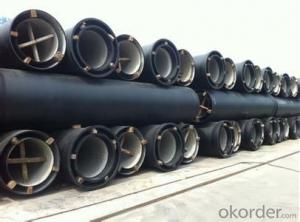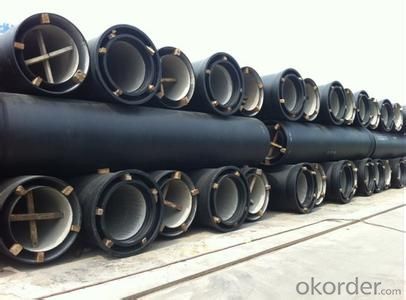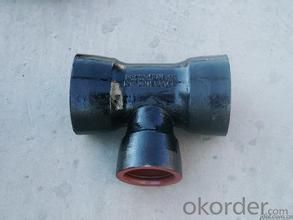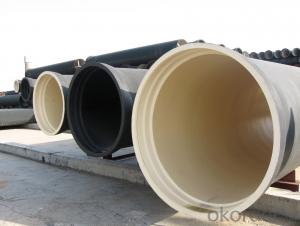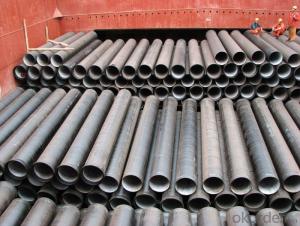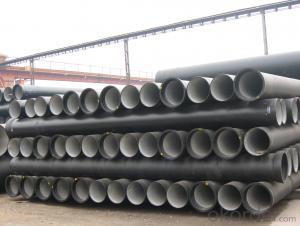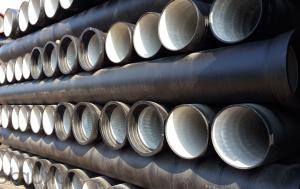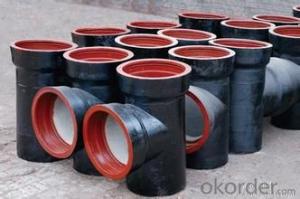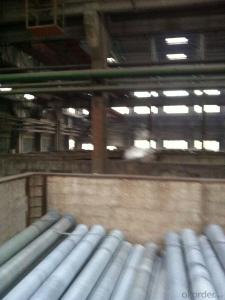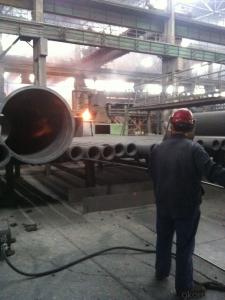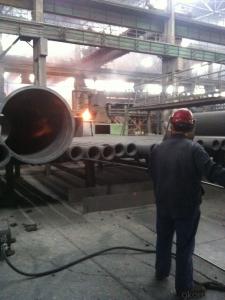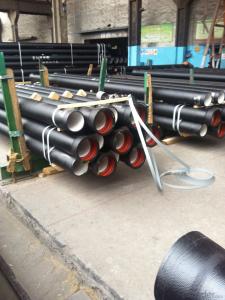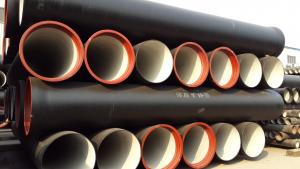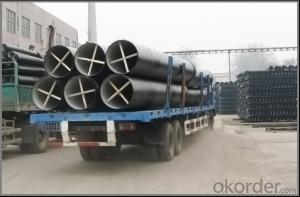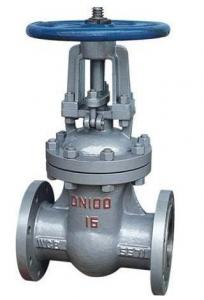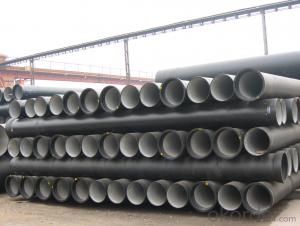DUCTILE IRON PIPES AND PIPE FITTINGS K9 CLASS DN100
- Loading Port:
- Tianjin
- Payment Terms:
- TT OR LC
- Min Order Qty:
- 22 pc
- Supply Capability:
- 3000 pc/month
OKorder Service Pledge
OKorder Financial Service
You Might Also Like
Material : Ductile Cast Iron
Size Range : DN 80mm to DN 2000mm
Unit Effective Length : 6m or 5.7m
Manufacture Standard: ISO 2531:1998/ EN 545:2006/EN 598:2007
Annual capacity : 200,000 tons
Coating Exterior: Zinc 130g/m2 according to ISO 8179-1 and bitumen coating 70 microns.
Cement Interior: Portland Cement/ High Alumina Cement/ Sulphate Resisting Cement Lining according to ISO 4179
Special requirements on external coating and internal lining can be applied
We also provide accessories such as SBR/EPDM rubber gaskets, lubricant paste, pipe caps, PE sleeves, etc.
Additional Parts:
Each pipe is strictly inspected according to related standard to ensure permanently high performance.
Easy Installation at site and service free for life
Long Service Lifespan
Quotation will arrive you within 24hours once we get your inquiry.
We guarantee offering you a competitive price.
A copy of original inspection reports of pipes will be offered after shipment.
Photos of loading process will be sent to the customer after shipment effect.
We will follow-up the delivery progress after shipment effect and update to the customer on weekly basis.
- Q: Are ductile iron pipes suitable for high-temperature applications?
- No, ductile iron pipes are not typically suitable for high-temperature applications as they have a lower melting point compared to other materials like steel.
- Q: Can ductile iron pipe be used for hot water applications?
- Indeed, hot water applications can make use of ductile iron pipe. Renowned for its robustness, longevity, and exceptional resistance to corrosion, ductile iron pipe proves itself ideal for diverse applications, including hot water systems. Its capability to withstand high temperatures and pressure renders it a dependable choice for the conveyance of hot water. Moreover, its thermal conductivity properties facilitate efficient heat transfer, guaranteeing the effective delivery of hot water throughout the system. Consequently, when evaluating materials for hot water applications, ductile iron pipe emerges as a fitting alternative.
- Q: What is cast iron pipe?
- According to its manufacturing methods can be divided into: sand, centrifugal pipe, straight pipe, continuous cast iron pipe and sand pipe.According to the material used, it can be divided into gray iron pipe, nodular cast iron pipe and high silicon iron pipe.
- Q: What is the average weight of ductile iron pipes?
- The average weight of ductile iron pipes can vary depending on the specific dimensions and specifications of the pipe. However, as a general guideline, ductile iron pipes typically range in weight from around 50 pounds per foot to 200 pounds per foot. The weight of a ductile iron pipe is influenced by factors such as the pipe's diameter, wall thickness, and length. It is important to note that these are average weights, and the actual weight of a specific ductile iron pipe may vary. To determine the exact weight of a ductile iron pipe, it is advisable to refer to the manufacturer's specifications or consult engineering guidelines.
- Q: How long does the cast iron pipe of indoor direct buried sewage need to be examined?
- Indoor drainage of the majority of households are using cast iron pipe, if the distance from the sewage well is relatively close, and the above does not take the car, you can consider the U-PVC.
- Q: Are ductile iron pipes resistant to chemicals?
- Yes, ductile iron pipes are generally resistant to chemicals. Ductile iron is a type of cast iron that has been alloyed with small amounts of magnesium to improve its strength and ductility. This alloying process enhances its resistance to corrosion and chemical attack. Ductile iron pipes have been widely used in various applications including water supply, wastewater treatment, and industrial piping systems where they may come into contact with a variety of chemicals. However, it is important to note that the resistance of ductile iron pipes to chemicals can vary depending on the specific type and concentration of the chemical involved. Therefore, it is advisable to consult the manufacturer or a qualified engineer to determine if ductile iron pipes are suitable for a particular chemical application.
- Q: Are ductile iron pipes suitable for deep burial installations?
- Indeed, deep burial installations can accommodate ductile iron pipes. These pipes possess remarkable strength and endurance, rendering them highly suitable for subterranean purposes. They possess the ability to withstand the immense pressure exerted by soil as well as any external forces that may arise. Moreover, ductile iron pipes exhibit exceptional resistance to corrosion, a vital characteristic for ensuring long-lasting performance in buried settings. Furthermore, their flexibility enables them to endure ground movements and settle without fracturing. All in all, ductile iron pipes represent a dependable and economically efficient option for deep burial installations.
- Q: What is the external coating used in ductile iron pipes?
- The external coating commonly used in ductile iron pipes is a protective layer made of either cement mortar or polyethylene.
- Q: How to analyze and judge the quality of ductile iron pipe
- On the quality of single pipe can analyze it from the surface is sand type and water cooled pipes, K8 pipe is different from Shanxi root nature is that the proportion of grade K9 cement and cast iron pipe and the K8 pipe are different, there is no national standard and non standard, no K8 tube, only is the production plant in order to obtain more profits, the dealer is not up to the national standard K9 grade pipe called K8 grade ductile pipe, K9 pipe cement weighs about 1/5 weight of the pipe, but is played in the role of anti-corrosion, the so-called K8 class water mud proportion some manufacturers terrifying 3/4 or 3/5, as the water supply pipe 3/5 or no personally think that two of the proportion of the tube is no problem
- Q: How are ductile iron pipes protected against external damage?
- Various protective measures are employed to shield ductile iron pipes from external damage. One commonly used method entails applying a protective coating to the pipe's outer surface. This coating acts as a barrier, preventing direct contact between the pipe and corrosive elements in the surrounding environment. Materials like epoxy, polyurethane, or zinc, which exhibit excellent resistance against corrosion, abrasion, and chemical attacks, can be utilized for this purpose. Furthermore, an additional layer of protection can be provided by encasing ductile iron pipes in a concrete or cement mortar lining. This lining not only reduces the likelihood of physical damage caused by external impacts or soil movement but also enhances the pipe's hydraulic performance by minimizing friction and maintaining a smooth flow of fluids. In addition, proper bedding and backfilling techniques are employed during the installation of ductile iron pipes. This involves using appropriate materials such as sand or gravel to support and stabilize the pipe, thereby minimizing the risk of external damage resulting from uneven ground settlement or heavy loads. Compacting the backfill material adequately is vital to ensure the long-term integrity and stability of the pipe. Regular inspection and maintenance are also crucial for safeguarding ductile iron pipes against external damage. Routine inspections can identify any signs of corrosion, coating deterioration, or physical harm, enabling timely repairs or replacement before significant issues arise. Additionally, employing proper cathodic protection systems can counteract electrochemical reactions occurring on the pipe's surface, preventing corrosion by applying an electric current. To summarize, the protection of ductile iron pipes against external damage encompasses the application of protective coatings, concrete or cement mortar linings, appropriate bedding and backfilling techniques, and regular inspections and maintenance. These measures collectively ensure the durability, longevity, and dependable performance of ductile iron pipes in various environments and applications.
Send your message to us
DUCTILE IRON PIPES AND PIPE FITTINGS K9 CLASS DN100
- Loading Port:
- Tianjin
- Payment Terms:
- TT OR LC
- Min Order Qty:
- 22 pc
- Supply Capability:
- 3000 pc/month
OKorder Service Pledge
OKorder Financial Service
Similar products
Hot products
Hot Searches
Related keywords
